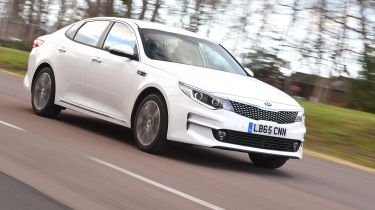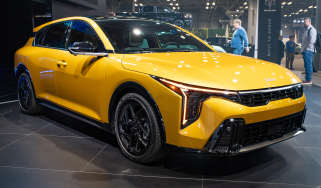Kia Optima review - Engines, performance and drive
The Optima is a competent cruiser, but out of its depth if you want driving thrills

In corners, the Optima is surprisingly agile, considering its relatively heavy kerbweight. It’s no sports car, but the chassis has plenty of grip and doesn’t tie itself in knots with quick direction changes. And while the steering lacks feedback and is a little vague, the Optima is marginally more engaging to drive than a VW Jetta. The car leans and rolls more in corners than we’d like though, and the Optima is most at home in the role of a comfortable cruiser.
Whether in town or on the motorway, the soft suspension soaks up bumps well, even on 18-inch wheels. The cabin is generally a quiet place to spend time, although when you get up to speed, the Optima's large wheels and tyres on higher-spec models generate noticeable road noise in the cabin. Wind noise is kept under control though, and even the engine – noisy under acceleration – settles down when cruising.
In the Optima PHEV, the extra weight of the batteries make their presence felt. On the road, the PHEV feels ponderous when compared to other plug-in rivals, and it gives the impression it has to work hard to overcome its weight. In electric mode it's not as smooth as a Prius Plug-in, as the gearbox jerkily engages the next ratio. Still, what the PHEV lacks in refinement when using its batteries, it makes up for with decent efficiency – we travelled around 35 miles in zero-emissions EV mode when we tested the Optima PHEV, despite the car’s trip computer claiming a 31-mile range after a full charge.
Used - available now

2022 Nissan
Micra
22,169 milesManualPetrol1.0L
Cash £10,700
2015 Volvo
S60
78,200 milesManualPetrol1.6L
Cash £7,400
2016 Tesla
Model S
78,000 milesAutomaticElectric
Cash £18,999
2019 Nissan
Micra
17,450 milesAutomaticPetrol1.0L
Cash £13,199However, it’s the ride and handling that let the Kia down most. Despite stiffer suspension, the car turns in lazily, while the steering is light and gives little feedback. Through fast turns the hefty batteries cause it to lurch uncomfortably as the extra weight over the back axle tries to force the rear wheels wide. The ESP cuts in smoothly, but it still feels disconcerting. Bumps and potholes aren’t filtered out as well as in rivals, while broken tarmac causes the Optima to shudder – a pity, because on smooth roads it’s quiet.
Engines
Fire up the Kia’s 1.7 CRDi diesel, and it sounds pretty rattly from both inside and outside the car. The Kia is let down by a rather flat power delivery, as it only really gets into its stride above 3,500rpm. The engine offers a slight improvement on the third generation car in performance terms though, as power is up to 139bhp and torque boosted to 340Nm. Kia claims a 0-62mph time of 10 seconds, but you have to work the engine hard to make progress as the Optima feel heavy.
Putting your foot down is not a particularly rewarding experience due to the noise and lack of refinement under acceleration. The manual gearbox feels a bit limp and disconnected too, so there’s not much about the Optima at all to encourage spirited driving. There is a seven-speed dual clutch auto option, which actually responds quite well to driver input – kicking down quickly and allowing you to better manipulate the car's slug of toruqe. It's not as engaging, though, and better suited to motorway driving.
The a PHEV plug-in hybrid offers a 33-mile all-electric range and can do 0-62mph in 9.4 seconds. The instant torque from the electric motor means it feels pretty peppy of the line, but it starts to fall behind at higher speeds. Unusually, the PHEV uses a six-speed twin-clutch gearbox rather than a CVT, and it suits the car nicely. It feels smooth and efficient, mating well with the car's relaxed nature.
When the 2.0-litre petrol engine fires into life, it’s noisy, but when we tested the PHEV it was a second faster than Kia’s 0-62mph claim. However, the Optima’s mass made itself evident during our in-gear tests, where it felty slow.








